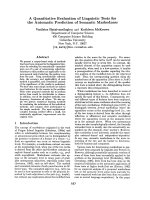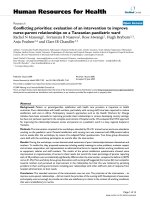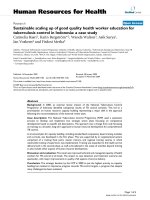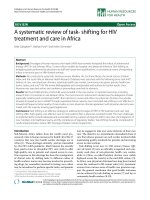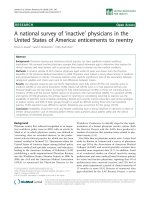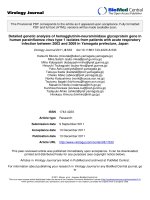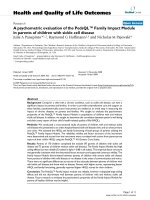Báo cáo sinh học: "A genetic evaluation of male reproductive fitness at early and late age in Drosophila melanogaster treated with" docx
Bạn đang xem bản rút gọn của tài liệu. Xem và tải ngay bản đầy đủ của tài liệu tại đây (725.64 KB, 14 trang )
Original
article
A
genetic
evaluation
of
male
reproductive
fitness
at
early
and
late
age
in
Drosophila
melanogaster
treated
with
a
mutagen
T
Björklund
,
G
Engström
LE
Liljedahl
Swedish
University
of
Agricultural
Sciences,
Department
of
Anirreal
Breeding
and
Genetics,
Box
7023,
S-750
07
Uppsala,
Sweden
(Received
26
February
1992;
accepted
2
June
1993)
Summary -
The
effect
of
ethyl
methane
sulfonate-induced
mutations
in
different
germ
cell
stages
on
male
reproductive
fitness
at
early
and
late
age,
compared
to
an
untreated
control,
was
investigated
in
a
laboratory
population
of
Drosophila
melanogaster.
Indication
of
active
DNA
repair
processes
after
mutagen
treatment
was
obtained
in
the
pre-meiotic
germ
cell
stages.
Genetic
parameters
for
the
male
fitness
trait,
ie
"number
of
progeny"
were
estimated
in
a
succession
of
different
broods
at
early
and
late
ages.
Heritability
estimates
for
progeny
size
were
found
to
vary
between
0.13
and
0.97
in
the
different
brood
stages
and
over
the
2
treatment
groups.
The
estimates
of
genotype-environment
interaction,
as
well
as
genetic
correlations,
suggest
that
the
genetic
determination
of
progeny
size
is
different
at
an
early
age
between
EMS-treated
and
untreated
individuals,
but
not
at
late
ages.
reproductive
fitness
/
Drosophila
melanogaster
/
genetic
parameter
/
ageing
/
mutagen
Résumé -
Évaluation
génétique
des
capacités
de
reproduction
de
mâles
de
différents
âges
exposés
à
un
agent
mutagène
chez
Drosophila
melanogaster.
Les
ef jets
des
mutations
induites
par
l’éthyl
méthanesulfonate
(EMS)
au
cours
des
différentes
phases
de
la
gamétogenèse
sur
la
capacité
de
reproduction
de
mâles,
jeunes
ou
âgés,
ont
été
étudiés
sur
une
population
de
laboratoire
de
Drosophila
melanogaster.
Des
processus
actifs
de
réparation
de
l’ADN,
après
traitement
par
l’EMS,
existent
vraisemblablement
au
cours
des
phases
préméiotiques.
Les
paramètres
génétiques
relatifs
au
nombre
de
descendants
par
mâle
ont
été
estimés
dans
plusieurs
séries
de
ponte
correspondant
à
différents
âges.
Les
estimations
de
l’héritabilité
de
ce
caractère
varient
de
0,17
à
0,67
dans
les
différentes
séries
de
ponte
et
dans
les
deux
groupes
de
mâles
traités
et
non
traités.
Les
estimations
des
interactions
génotype-milieu,
ainsi
que
des
corrélations
génétiques
suggèrent
que
le
déterminisme
génétique
du
nombre
de
descendants
est
différent
chez
les
jeunes
mâles
*
Correspondence
and
reprints
exposés
à
l’EMS
par
rapport
aux
mâles
non
traités.
En
revanche,
aucune
différence
n’est
détectée
chez
les
mâles
plus
âgés.
capacité
de
reproduction
/
Drosophila
melanogaster
/
paramètre
génétique
/
vieil-
lissement
/
mutagène
INTRODUCTION
’
’
Drosophila
melanogaster
is
widely
used
to
evaluate
genetic
damage
resulting
from
exposure
to
chemical
mutagens.
Several
standard
techniques
for
feeding
adult
flies
with
mutagenic
substances
(Lewis
and
Bacher,
1968;
Felix,
1971)
can
be
used
to
induce
a
spectrum
of
relevant
genetic
damage
in
the
different
germ
cell
stages.
To
evaluate
such
genetic
damage,
assay
test
systems
for
the induction
of
recessive
lethals
in
the
X-chromosome,
which
represent
one-fifth
of
the
Drosophila
genome,
are
the
simplest
and
most
commonly
used.
One
characteristic
feature
of
chemical
mutagens
is
their
specificity
of
action.
In
cases
of
very
pronounced
stage
specificity,
testing
only
one
germ
cell
stage
can
lead
to
false
negative
results
(Wurgler
et
al,
1984).
In
Drosophila,
sensitivity
differences
between
germ
cell
stages
can
be
assessed
by
mating
treated
males
to
virgin
females
in
a
succession
of
different
broods.
The
assay
systems
often
used
in
mutation
research
focus
on
standard
genetic
endpoints,
ie,
point
mutations
with
major
and
discrete
effects
and chromosomal
ab.err.ations.
However,
when
considering
mutations
affecting
the
polygenic
systems
of
fitness
characters,
quantitative
genetic
analysis
can
contribute
important
infor-
mation
to
the
understanding
of
these
mechanisms
(see
eg
Ramel,
1983).
The
genetic
effect
on
male
fertility
after
mutagen
treatment
in
a
succession
of
different
broods
depends
on
several
factors
such
as:
1)
the
ability
of
the
mutagen
to
reach
the
germ
cells;
2)
the
kind
of
damage
caused
by
the
mutagen
on
the
germ
cells,
which
is
dose-dependent
for
many
mutagens;
and
3)
the
extent
to which
this
damage
is
eliminated
through
various
repair
mechanisms.
Ethyl
methane
sulfonate
(EMS)
is
a
known
mutagen
which
reaches
all
germ
cell
stages.
EMS
produces
alkylated
purine
adducts
on
the
DNA
in
germ
cells.
These
alkylated
purine
adducts
are
readily
removed
by
excision
repair
systems.
However,
in
late
stages
of
post-meiotic
cells,
the
repair
ability
is
deficient
(Sega,
1979;
Sobel,. 1972).
In
contrast
to
late
stages
of
post-meiotic
germ
cells,
pre-meiotic
cells
are
believed
to
have
DNA
repair
enzymes.
Indications
of
efficient
DNA
repair
systems
have been
found
in
spermatogonial
germ
cells
of
Dro.sophila
(Smith
et
al,
1983;
Vogel
and
Zijlstra,
1987)
and
mouse
(Russel,
1986).
In
addition
to
DNA
repair,
segregational
elimination
of
deleterious
mutations
during
meiosis
(germinal
selection)
seems
to
reduce
the
realization
of
EMS-induced
genetic
damage
in
pre-
meiotic
germ
cells
of
Drosophila
(Vogel
and
Zijlstra,
1987).
An
equal
reduction
in
the
number
of
both
female
and
male
offspring
and
a
high
sterility
among
individuals
from
pre-meiotic
cells
is
an
indication
of
germinal
selection.
,
The
objective
of
this
study
was
to
explore
the
effect
of
EMS-induced
mutations
in
different
germ
cell
stages
on
male
reproductive
fitness
at
early
and
late
ages.
Further,
we
investigated
whether
male
reproductive
fitness
is
a
genetically
different
trait
after
EMS
treatment
compared
to
normal
reproductive
fitness.
Quantitative
genetic
parameters
for
number
of
offspring
as
well
as
more
standard
genetic
endpoints
( eg,
sex
proportion)
were
estimated
in
a
succession
of
different
broods
at
early
and
late
age
after
an
initial
treatment
with
EMS
and
compared
to
a
control
not
exposed
to
EMS.
.i
,
j
.
MATERIAL
AND
METHODS ’
i
.
The
population
of
Drosophila
melanogaster
used
in
this
study
was
obtained
from
crosses
between
4
laboratory
wild-type
strains
of
different
origin,
each
contributing
equally
to
a
4-way
hybrid
strain.
This
hybrid
strain,
consisting
of
>
400
individuals
of
each
sex
per
generation,
was
allowed
to
attain
linkage
equilibrium
through >
30
generations
of
random
mating.
A
sample
of
26
sires
and
78
dams
were
taken
at
random
and
each
sire
was
mated
with
3
dams.
The
sons
from
these
matings
(!
8
per
dam)
were
collected
within
12
h
in
order
to
obtain
approximately
the
same
stage
of
sexual
maturity.
All
sons
were
kept
in
vials
containing
2
cm
standard
medium
(10
g
agar,
60
g
syrup,
50
g
baker’s
yeast,
40
g
powdered
mashed
potatoes,
0.75
g
ascorbic
acid
and
2
ml
propionic
acid
per
1
water).
The
flies
were
maintained
in
an
incubator
at
25°C
and
55%
relative
humidity.
Photoperiod
was
16L:8D.
All
handling
was
performed
at
room
temperature
using
carbon
dioxide
anaesthesia.
The
sons
in
each
full
sib
group
were
kept
together
until
treatment,
ie
3
d after
eclosion.
Half
the
number
of
sons
from
all
full
sib
groups
were
individually
exposed
to
EMS
for
24
h
using
the
method
described
by
Lewis
and
Bacher
(1968),
but
with
a
lower
EMS
concentration
(5.0
x
10-
3
M).
The
other
half,
the
control
group,
was
treated
in
the
same
manner,
except
that
no
EMS
was
added
to
the
medium.
Immediately
after
treatment
each
son
was
placed
in
a
vial
with
3
virgin
&dquo;attached-
X&dquo;
(XX)
females
and
kept
in
these
vials
for
2
consecutive
egg-laying
days.
Each
son
was
then
transferred
to
a
new
vial
with
a
new
set of
3
virgin
XX-females
for
another
egg-laying
period
of
2
d,
and
the
former
set
of
XX-females
were
discarded.
This
procedure
was
repeated
5
times
with
egg-laying
periods
starting
at
4, 6,
8,
10
and
12
d after
eclosion
and
representing
fertility
at
an
early
age.
Sex
chromosomes
of
XX-females
consist
of
2
X-chromosomes
and
1
Y-chromo-
some.
The
2
X-chromosomes
are
attached
to
each
other
and
segregate
together
during
meiosis.
Due
to
the
genetic
constitution
of
XX-female,
male
offspring
of
these
females
get
their
X-chromosomes
from
the
sire
(see
fig
1).
Thus,
the
proportion
of
male-to-female
offspring
from
the
cross
between
a
wild-type
male
and
an
XX-female
reflects
the
genetic
load
in
the
sire
X-chromosome.
Each
successive
brood
constitutes
a
sample
of
germ
cells
that
received
EMS
at
different
stages
of
spermatogenesis.
Thus,
the first
brood
was
produced
from
cells
that
were
mature
sperm
at
the
time
of
treatment;
the
second
brood
from
late
spermatids;
the
third
brood,
early
spermatids;
the
fourth
brood,
meiotic
stages
and
the
fifth
brood
from
spermatogonia.
During
the
egg-laying
period
in
brood
5
starting
at
d
12,
son
groups
were
kept
in
vials
for
3
consecutive
d
instead
of
2.
This
was
done
in
order
to
prolong
the
pre-meiotic
period
so
that
germ
cells
of
all
sons
in
brood
5
had
reached
the
spermatogonial
stage,
since
there
is
individual
variation
in
the
rate
of
spermatogenesis
(Wurgler
et
al,
1984).
Following
the
fifth
mating
period,
all
sons
were
placed
separately
in
new
vials,
twice
a
week, for
20
d.
After
the
ageing
period
each
son
was
mated
with
a
new
set
of
3
virgin
XX-females
for
2
consecutive
egg-laying
d
as
described
above.
This
procedure
was
repeated
once
more.
Broods
6
and
7
represent
fertility
at
a
late
age
(35
and
37
d after
eclosion).
All
XX-females
used
in
the
experiment
were
between
3
and
5
d
of
age.
The
total
number
of
offspring
from
each
son,
the
sex
proportion
(number
of
males
divided
by
total
number
of
progeny
in
each
brood)
and
the
proportion
of
sterile
sons
were
calculated
for
each
brood.
In
order
to
discriminate
between
males’
and
females’
designation
in
different
generations,
a
schematic
representation
of
the
experimental
design
is
shown
in
figure
2.
Genetic
parameters
for
number
of
progeny
in
the
different
broods
within
the
2
treatment
groups
were
calculated
by
the
method
of
multivariate-restricted
maxi-
mum
likelihood,
using
a
random
animal
model
with
breeding
value
of
sons
as
the
only
factor.
A
relationship
matrix
was
used
to
take
into
account
the
covariance
be-
tween
relatives
(Meyer,
1986).
A
restriction
imposed
was
that
only
sons
present
in
all
broods
within
a
treatment
and
having
adult
offspring
in
brood
1
were
included
in
the
analysis.
Standard
errors
were
calculated
according
to
Meyer
(1985,
1986).
In
order
to
estimate
genotype-environment
interactions
and
genetic
correlations
for
number
of
offspring
between
the
2
treatment
groups,
the
appropriate
variance
components
were
also
estimated
(SAS
Inc,
1982)
using
the
model:
where:
Y2!!
k
=
observed
number
of
offspring;
J
’l
=
general
mean;
Bi
=
fixed
effect
of
the
ith
treatment
(i
=
1, 2);
fj
=
random
effect
of
fullsib
group
( j
=
1 78),
with
mean
0
and
variance
!2.
f’
(Bf)
ij
=
interaction
effect
between
fullsib
group
and
treatment,
with
mean
0
and
variance
cr2 Bf;
I
e
ijk
=
random
residual
effect
associated
with
the
ijkth
record,
with
mean
0
and
variance
Q
e.
Genetic
correlations
between
the
2
treatment
groups
for
number
of
offspring
were
calculated
according
to
Yamada
(1962).
RESULTS
Number
of
progeny
The
mean
values
for
female
and
male
progeny
in
the
different
broods
are
presented
in
table
I.
Total
number
of
offspring
after
EMS
treatment
was
significantly
lower
than
the
control
for
broods
1-5
(p
<
0.001),
and
brood
6 p
<
0.01),
but
not
brood
7.
However,
the
effect
of
treatment
was
consistently
larger
in
males
than
in
females.
Within
the
control
group,
the
total
number
of
progeny
in
brood
1
was
significantly
lower
(p
<
0.001)
than
the
other
stages
at
an
early
age
(3-14
d).
In
the
EMS-treated
group
there
was
a
considerable
variation
in
this
trait.
Sex
proportion
The
difference
in
sex
proportion
(table
II)
between
the
control
and
the
EMS
treated
group
is
high
in
broods
1
to
3
(13.13-14.38),
whereas
only
small
differences
remain
in
broods
4
to
7
(0.68-5.82).
Within
the
control
group
the
variation
in
sex
proportion
was
small
between
different
broods.
This
finding
is
consistent
with
an
earlier
study
by
Bj6rklund
et
al
(1988)
where
sex
ratio
was
calculated
at
3
different
age
periods
and
no
significant
differences
were
obtained.
In
the
EMS
treated
group,
a
lower
sex
proportion
was
obtained
in
broods
1
to
3
(44.78-45.35%)
than
in
broods
4
to
7
(56.16-57.70%):
The
sex
proportion
in
broods
1
to
3
after
EMS
treatment
were
on
average
23%
lower
than
the
same
broods
in
the
control
group,
which
is
parallel
to
an
investigation
by
Vogel
and
Natarajan
(1979).
At
the
same
concentration
of
EMS
used
as
in
this
investigation,
frequency
of
recessive
lethal
mutations
was
found
by
them
to
be x5
20%.
Sterility
Within
the
control
group
the
proportion
of
sterile
sons
increased
linearly
from
1.7%
in
the
first
brood
to
84.9%
in
the
seventh
brood
(table
II).
In
the
EMS-treated
group
the
proportion
of
sterile
sons
increased
from
its
minimum
value,
2.1%,
in
the
second
brood
to
89.1%
in
the
seventh
brood.
Brood
4
deviated
from
this
pattern
with
a
considerably
higher
proportion
of
sterile
sons
(65.4%).
Quantitative
genetic
parameters
Heritabilities
as
well
as
genetic
and
phenotypic
correlations
for
total
number
of
offspring
in
the
different
broods
of
the
control
group
are
presented
in
tables
III
and
IV
for
the
EMS-treated
group.
Genotype-environment
interactions
and
genetic
correlations
estimated
between
the
2
treatment
groups
and
within
brood
stage
are
presented
in
table
V.
Due
to
the
small
number
of
progeny
obtained
(brood
7
in
the
control
and
the
EMS
group;
brood
4
in
the
EMS-treated
group),
brood
7
was
from
all
analysis
of
quantitative
genetic
parameters,
whereas
brood
4
was
only
excluded
from
the
analysis
of
genotype-environment
interactions,
genetic
correlations
estimated
between
the
2
treatment
groups
and
genetic
parameters
estimated
within
the
EMS-treated
group.
Heritabilities
The
heritability
for
number
of
progeny
in
the
first
brood
was
very
high
both
for
the
control
(0.79)
and
for
the
EMS-treated
group
(0.97).
In
broods
2
to
6
heritabilities
varied
from
0.17
to
0.66
in
the
control
group
and
from
0.13
to
0.67
in
the
EMS-
treated
group,.
but
were
not
significant
in
broods
3
and
6
for
either
the
control
or
the
EMS-treated
groups.
Genetic
correlations
within
treatment
A
clear
pattern
of
genetic
correlations
was
not
discernible
within
early
age
broods,
nor
between
early
and
late
age
broods,
and
most
genetic
correlations
were
not
significant
in
the
control
group.
Most
of
the
phenotypic
correlations
were
significant
and
positive.
In
the
EMS-treated
group,
there
were
significant
positive
genetic
correlations
between
broods
close
to
each
other
in
time,
except
for
the
correlation
between
brood
1
and
brood
2,
which
was
negative.
Most
phenotypic
correlations
in
the
EMS-treated
group,
although
lower
than
the
phenotypic
correlations
in
the
control
group,
were
positive
and
significant.
Genotype—environment
interaction
and
genetic
correlations
between
treatments
Genotype-environment
interactions
in
broods
1
and
2
were
significant
at
the
P
<
0.0001
level
and
in
brood
5
at
the
P
<
0.01
level.
There
were
no
signifi-
cant
genotype-environment
interactions
in
broods
3
and
6.
The
method
used
to
calculate
genetic
correlations
within
brood
stage
for
number
of
offspring
between
the
2
treatment
groups
gave
a
correlation
of -1.00
in
brood
1
and
1.02
in
brood
6.
DISCUSSION
Several
experiments
have
investigated
the
genetic
covariation
of
fitness
traits
in
populations
not
exposed
to
mutagens.
According
to
Falconer
(1981),
at
a
negligible
rate
of
mutations,
additive
genetic
variance
in
major
components
of
fitness
can
be
maintained
only
in
the
presence
of
a
negative
genetic
correlation.
However,
both
negative
(Rose
and
Charlesworth,
1981;
Luckinbill
et
al,
1984;
Tucic
et
al,
1988)
and
positive
genetic
correlations
(Giesel
1986;
Engstr6m
et
al,
1989)
have
been
found
among
fitness
traits
measured
at
different
life
history
stages.
Classical
quantitative
genetic
theory
generally
assumes
that
inbreeding
causes
spurious
patterns
of
positive
genetic
correlations
(Rose,
1984).
However,
genetic
correlations
do
not
measure
the
inherent
action
of
genes,
but
rather
provide
statistical
descriptions
of
populations
within
particular
contexts
of
environments
and
genotypic
frequencies.
Therefore,
it
may
not
be
meaningful
to
discuss
genetic
correlations
for
life
history
fitness
components
found
in
different
investigations
(Clark,
1987).
study
deals
with
the
effect
of
EMS-induced
genetic
damages
in
germ
cells
on
male
reproductive
fitness
at
early
and
late
age.
The
EMS
concentration
used
in
this
investigation
is
not
expected
to
produce
genetic
changes
other
than
point
mutations,
unless
sperm
is
being
stored
(Vogel
and
Natarajan,
1979).
Due
to
the
genetic
constitution
of
the
XX-females,
male
offspring
from
these
females
get
their
X-chromosome
from
their
father.
Thus,
X-linked
deleterious
mutations
affecting
viability
will
reduce
the
number
of
male
progeny
and
result
in
female-biased
sex
proportion.
At
an
early
age,
broods
1
to
3
after
EMS
treatment
are
similar
in
that
they
have
lower
sex
proportion
and
rates
of
sterility
approximately
twice
that
of the
untreated
flies.
The
reduced
number
of
male
offspring
accounts
for
most
of
the
reduction
in
total
number
of
progeny,
indicating
that
the
induced
mutations
are
mainly
recessive.
Almost
normal
sex
proportion
in
broods
4
and
5
after
EMS
treatment
suggests
that
efficient
DNA
repair
processes
exist
in
the
meiotic
and
spermatogonial
germ
cell
stages.
The
reduction
in
both
female
and
male
offspring
and
the
higher
sterility
in
broods
4-5
indicate
that
germinal
selection
is
an
important
mechanism
in
eliminating
deleterious
mutations.
Vogel
and
Zijlstra
(1987)
reported
similar
results.
At
later
ages,
differences
in
number
of
offspring
and
sterility
between
the
EMS-
treated
group
and
the
control
group
are
smaller,
and
no
significant
difference
in
number
of
offspring
was
obtained
for
brood
7.
However,
the
sex
proportion
is
slightly
lower
in
the
EMS-treated
group.
These
results
suggest
that
most,
but
not
all,
of
the
deleterious
mutations
induced
early
in
life
are
eliminated.
Heritability
estimates
found
in
the
literature
for
fecundity
of
female
Drosophila
vary
between
0.02
and
0.40
(Rose
and
Charlesworth,
1981;
Tucic
et
al,
1988;
Engstr6m
et
al,
1989).
The
total
number
of
progeny
in
brood
1
had
a
higher
estimated
heritability
than
was
expected.
Furthermore,
there
were
significantly
fewer
offspring
in
brood
1
of
the
control
group
than
in
the
other
early
age
brood
stages.
This
and
the
negative
correlation
between
brood
1
and
brood
2
suggest
that
number
of
progeny
in
brood
1
is
a
trait
that
includes
both
fertility
and
sexual
maturity.
High
heritability
estimates
have
been
found
for
sexual
maturity
in
other
species,
such
as
for
example
laying
hens
(Liljedahl
et
al,
1984).
The
heritability
estimates
obtained
in
the
other
brood
stages
are,
on
average,
higher
than
estimates
of
female
fecundity
reported
in
the
literature.
Heritability
for
the
male
reproductive
component
was
about
twice
the
size
of
the
heritability
of
female
fecundity
in
an
investigation
reported
by
Tucic
et
al
(1988).
Brittnacher
(1981)
found
that
genetic
load
due
to
virility
was
greater
than
that
due
to
the
female
reproductive
component.
This
suggests
that
the
male
reproductive
component
may
contain
more
genetic
variance
than
the
female
component.
Heritability
at
late
ages
(brood
6)
is
not
significant,
probably
due
to
increased
environmental
variation
as
well
as
non-additive
genetic
variation.
This
has
been
observed
in
several
studies
where
the
animals’
reactions
to
stressful
environments
and
different
ages
has
been
investigated
(Flock,
1977;
Liljedahl
et
al,
1984;
Rose
and
Charlesworth,
1981;
Burla
and
Taylor,
1982).
As
only
a
few
of
the
genetic
correlations
estimated
were
significant,
caution
is
nec-
essary
when
interpreting
the
covariance
structure
among
fitness
components.
How-
ever,
many
fewer
negative
genetic
correlations
were
obtained
in
the
EMS-treated
group
than
in
the
control
group.
Whether
the
difference
in
genetic
correlations
be-
tween
the
control
and
the
EMS-treated
group
is
due
to
sampling
variance
or
caused
by
EMS
treatment
cannot
be
clearly
distinguished
in
the
present
investigation,
but
this
difference
is
believed
to
be
an
effect
of
EMS,
because
of
the
smaller
sampling
variances
in
EMS-treated
group.
The
genetic
correlations
estimated
in
this
experiment
were
based
on
reproduction
data
from
Drosophila
males.
However,
most
other
studies
which
found
significant
covariance
structures
among
life
history
fitness
components
have
used
Drosophila
females
(Rose
and
Charlesworth,
1981;
Luckinbill
et
al,
1984;
Giesel,
1986;
En-
gstr6m
et
al,
1989).
Tucic
et
al
(1988)
estimated
genetic
correlations
of
life
history
fitness
components
on
both
sexes
and
concluded
that
the
genetic
covariance
struc-
ture
between
fitness
components
differs
between
sexes.
At
an
early
age,
genotype-environment
interactions
as
well
as
genetic
correlations
between
the
2
treatment
groups
and
within
broods
vary
depending
on
the
different
genetic
events
in
spermatogenesis.
In
the
post-meiotic
period,
(broods
1-3)
highly
significant
genotype-environment
interactions
were
obtained
for
number
of
progeny
in
broods
1
and
2,
which
is
indicated
by
high
negative
genetic
correlations.
No
significant
genotype-environment
interaction
was
obtained
in
brood
3
and
the
genetic
correlation
was
moderate
to
high
and
positive.
This
finding
is
unexpected,
because
the
sex
proportion,
sterility
rate
and
total
number
of
progeny
obtained
in
the
3
broods
were
all
very
similar.
A
possible
explanation
for
the
high
negative
correlations
found
in
broods
1
and
2
could
be
variation
in
consumption
and
uptake
of
EMS,
which
may
be
negatively
coupled
to
fertility
in
the
sense
of
sexual
activity.
More
sexually
active
males
may
require
greater
amounts
of
energy
and
therefore
consume
more
EMS,
which
in
turn
could
lead
to
a
smaller
number
of
progeny
as
a
result
of
more
serious
DNA
damage
in
the
germ
cells.
In
the
spermatogonial
stage
(brood
5)
a
significant
genotype-environment
interaction,
as
well
as
a
low
negative
genetic
correlation
was
obtained.
This,
together
with
an
almost
restored
sex
proportion
and
reduced
number
of
progeny
suggests
that
DNA
repair
and
germinal
selection
are
interfering
with
&dquo;normal&dquo;
fertility.
At
a
late
age
(brood
6),
no
significant
genotype-environment
interactions
were
observed
and
the
genetic
correlation
between
the
2
treatment
groups
was
high
and
positive.
This
finding
suggests
that
the
same
set
of
genes
are
determining
male
fertility
measured
as
&dquo;number
of
progeny&dquo;
in
the
2
treatment
groups,
which
is
confirmed
by
the
fact
that
sex
proportion
and
sterility
are
restored
to
an
almost
normal
level
and
the
difference
in
number
of
progeny
is
diminishing.
We
conclude
that
DNA
repair
processes
are
actively
present
in
the
meiotic
and
earlier
stages
after
an
initial
EMS
treatment,
because
sex
proportion
was
restored
to
an
almost
normal
level
in
these
germ
cell
stages.
The
heritability
for
number
of
progeny
in
brood
1
is
very
high
for
both
the
EMS
treated
group
and
the
control.
This
finding
suggests
that
number
of
progeny
includes
both
fertility
and
sexual
maturity.
In
the
other
brood
stages,
heritabilities
were
found
to
vary
between
0.17
and
0.67.
Finally,
we
suggest
that
the
trait
&dquo;number
of
progeny&dquo;
at
an
early
age
is,
to
a
great
extent,
genetically
expressed
in
the
EMS-treated
individuals
differently
from
the
untreated
control.
This
conclusion
is
based
on
the
partly
different
pattern
of
genetic
correlations
within the
2
treatment
groups,
the
genotype-environment
interaction,
and
the
genetic
correlations
between
the
2
treatment
groups
found.
At
lates
ages,
the
trait
&dquo;number
of
progeny&dquo;
is
essentially
expressed
in
the
same
way
because
the
genetic
correlation
between
the
2
treatment
groups
is
positive
and
high
and
there
is
no
significant
genotype-environment
interaction.
ACKNOWLEDGMENTS
The
authors
are
grateful
to
S
Johansson
and
A
Schultz
for
excellent
technical
assistance
and
to
H
Jorjani,
C
Glynn
and
M
Blackmore
for
helpful
comments.
REFERENCES
Bj6rklund
T,
Engstr6m
G,
McKay
T,
Liljedahl
LE
(1988)
Search
for
age-dependent
as
compared
to
mutagen-induced
mutations
on
the
X-chromosome
affecting
viabil-
ity
in
Drosophila
melanoga.ster
males.
Genet
Sel
Evol
20,
409-416
Brittnacher
JG
(1981)
Genetic
variation
and
genetic
load
due
to
the
male
repro-
ductive
component
of
fitness
in
Drosophila.
Genetic.s
97,
719-730
Burla
H,
Taylor
CE
(1982)
Increase
of
phenotypic
variance
in
stressful
environ-
ments.
J
Hered
73,
142
Clark
AG
(1987)
The
covariation
hang-up
of
senescence.
Am
Nat
129,
932-934
Engstr6m
G,
Liljedahl
LE,
Rasmuson
M,
Bj6rklund
T
(1989)
Expression
of
genetic
and
environmental
variation
during
ageing.
1.
Estimation
of
variance
components
for
number
of
adult
offspring
in
Drosophila
melanogaster.
Theor
Appl
Genet
77,
119-122
Falconer
DS
(1981)
Introduction
to
Quantitative
Genetics.
Longman,
London
Felix
R
(1971)
A
system
for
feeding
liquids
to
adult
flies.
Dros
Inf
Serv
47,
129
Flock
DK
(1977)
Prediction
of
full-year
egg
production
from
part
records
in
a
population
of
white
Leghorns
under
long-term
RRS.
Z
Tierz
Zuchtungsbiol
94,
80-
103
Giesel
J
(1986)
Genetic
correlation
structure
of
life
history
variables
in
outbred,
wild
Drosophila
melanoga.ster.
effects
of
photoperiod
regimen.
Am
Nat
128,
593-603
Lewis
EB,
Bacher
F
(1968)
Method
of
feeding
ethyl
methane
sulfonate
(EMS)
to
Drosophila
males.
Dros
Inf
Serv
43,
193
Liljedahl
LE,
Gavora
JS,
Fairfttll
RW,
Gowe
RS
(1984)
Age
changes
in
genetic
and
environmental
variation
in
laying
hens.
Theor
Appl
Genet
67,
391-401
Luckinbill
LS,
Arking
R,
Clare
MJ
(1984)
Selection
for
delayed
senescence
in
Drosophila
melanogaster.
Evolution
38,
996-1003
Meyer
K
(1985)
Maximum
likelihood
estimation
of
variance
components
for
a
multivariate
mixed model
with
equal
design
matrices.
Biometrics
41,
153-165
Meyer
K
(1986)
Restricted
maximum
likelihood
estimation
of
variance
components-
in
practice.
In:
Proc
3rd
World
Congr
Genet
Appl
Livestock
Prod
(Dickerson
GE,
Johnson
RK,
eds)
(Lincoln,
July
16-22
1986,
vol
XII.)
Univ
Nebraska,
Lincoln,
NE,
454-459
Ramel
C
(1983)
Polygenic
effects
and
genetic
changes
affecting
quantitative
traits.
Mutat
Re.s
114,
107-116
Rose
MR
(1984)
Genetic
covariation
in
Drosophila
life
history:
untangling
the
data.
Am
Nat
123,
565-569
Rose
MR,
Charlesworth
B
(1981)
Genetics
of
life
history
in
Dro.sophila
melano-
ga.ster.
I.
Sib
analysis
of
adult
females.
Genetics
97,
173-186
Russel
W
(1986)
Positive
genetic
hazard
predictions
from
short-term
tests
have
proved
false
from
results
in
mammalian
spermatogonia
with
environmental
chem-
icals.
In:
Genetic
Toxicology
of
Environmental
Chemicals,
Part
B:
Genetic
Effects
and
Applied
Mutagene.si.s
(Ramel
C,
Lambert
B,
Magnusson
J,
eds)
Alan
R
Liss
Inc,
New
York,
67-74
SAS
Institute
Inc
(1982)
SAS
U.ser’.s
Guide.
SAS
Institute
Inc,
Cary,
NC
Sega
GA
(1979)
Unscheduled
DNA
synthesis
(DNA
repair)
in
germ
cells
of
male
mice.
Its
role
in
the
study
of
mammalian
mutagenesis.
Genetic.s
92,
549-558
Smith
PD,
Baumen
CF,
Dusenbery
RL
(1983)
Mutagen
sensitivity
of
Drosophila
melanoga.ster.
VI.
Evidence
from
the
excision-defective
mei-9AT1
mutant
for
the
timing
of
DNA
repair
activity
during
spermatogenesis.
Mutat
Res
108,
175-184
Sobels
FH
(1972)
A
dose-fractionation
study
to
determine
how
long
breaks
induced
in
various
stages
of
spermatogenesis
of
Dro.sophila
stay
open.
Rev
Suis.se
Zool
79,
143-152
Tucic
N,
Cuetkovic
D,
Milanov
D
(1988)
The
genetic
variation
and
covariation
among
fitness
components
in
Dro.sophila
melanogaster
females
and
males.
Heredity
60,
55-60
Vogel
E,
Natarajan
AT
(1979)
The
relation
between
reaction
kinetics
and
muta-
genic
action
of
mono-functional
alkylating
agents
in
higher
eukaryotic
systems.
1.
Recessive
lethal
mutations
and
translocations
in
Drosophila.
Mutat
Res
62,
51-100
Vogel
EW,
Zijlstra
JA
(1987)
Somatic
cell
mutagenicity
in
Drosophila
melanogaster
in
comparison
with
genetic
damage
in
early
germ-cell
stages.
Mutat
Res
180,
189-
200
Wurgler
FE,
Sobel
FH,
Vogel
E
(1984)
Drosophila
as
an
assay
system
for
detecting
genetic
changes.
In:
Handbook
of
Mutagenicity
Test
Procedures
(Kilbey
BJ,
Legator
M,
Nichols
W,
Ramel
C,
eds)
Elsevier
Sci
Publ
BV,
Amsterdam,
555-601
Yamada
Y
(1962)
Genotype
by
environment
interaction
and
genetic
correlation
of
the
same
trait
under
different
environments.
Jpn
J
Genet
37,
498-509

